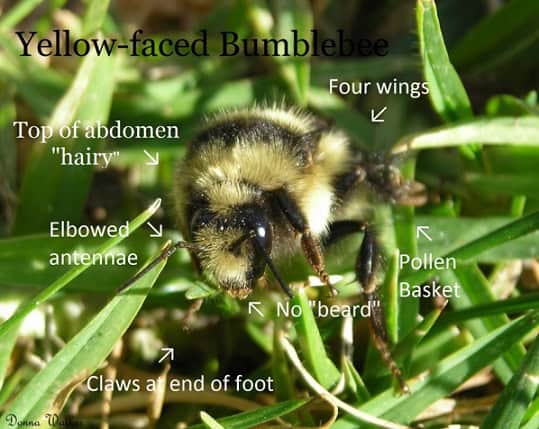Robber Flies – The Great Pretenders
This morning I stood in the doorway of Gerry´s office and declared:
“Gerry, I am very disappointed in the animal kingdom, specifically insects!”
“Why? What´s going on?”
“Well…..remember that picture I took of what I thought was a furry,
sweet-looking mimic Bumblebee fly? Turns out it´s a garden monster!!!”
“Why, what does it do?”
“It lurks on the leaves of plants watching for innocent honey bees
(all the while pretending to be a bee itself), then catches the bee with its strong forelegs, paralyzes it and sucks all the juices out – leaving nothing but an empty bee shell!”
“Well, that´s how nature is….”
“I know, I know….don´t even get me started on Tarantula Hawks!”
Then I went back to my office and started writing about this “Garden Monster” or as my Park Ranger friend Jeff calls them, “the Arnold Schwarzenegger of insects.”

Bumblebee Mimics
Mimics are great pretenders. This particular mimic above is trying very hard to look like a Bumblebee, not only to deceive unsuspecting honeybees and wasps, which it feeds on, but other would-be predators into thinking it is a real live, Bumblebee – capable of stinging. In actuality, it´s just a fly……a robber fly robbing the life right out of its prey.

Robber flies are of the family Asilidae (true flies); they have just two wings (and no stinger), whereas wasps and bees have four wings. These mimics are also called “assassin flies” because they lie in wait until an unsuspecting wasp, bee, butterfly, or beetle passes by, then the bumblebee mimic attacks. It uses its dagger-like proboscis to cut into the victim´s skeleton and then injects a combination of venom and digestive enzymes. This enables the robber fly to both paralyze and liquefy the innards of its victim – and then suck them dry.

Native to the west coast of North America
Bumblebee Mimic Habitat and Behavior
The “Garden Monster” is rarely seen and often mistaken for a Bumblebee. These assassins behave similar to a wolf-in-sheep´s-clothing, perching quietly in gardens, appearing like an innocent Bumblebee but when it sees an insect fly by, it zooms out to nab it. Real Bumblebees are non-predatory. Bumblebee mimics live close to the ground; their larvae are found in soil or rotting wood, pupating near the surface in order to emerge easily from their pupa cases.
Video of Bumblebee Mimic Robber Fly
The Robber Fly´s Value in Pest Management – or not?
Bumblebee robber flies are considered beneficial because they prey on beetles, grasshoppers, wasps, ants, moths, other flies, and even spiders. But, they also prey on beneficial insects such as butterflies, honeybees, dragon and damselflies. These miniature assassins unfortunately do not discriminate when hunger strikes them. Next time you see a bumblebee, check and see if it has a beard before you say “oh, look at the pretty bumblebee!” It just may be a monster in disguise!

Article by Donna Walker
References
University of Kentucky Department of Entomology – Kentucky Critter Files
Wikipedia.org/wiki/Asilidae
Department of Entomology, North Carolina State University, Raleigh, NC


